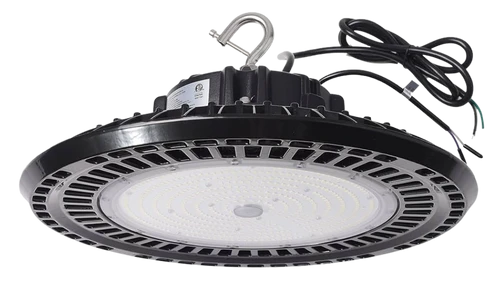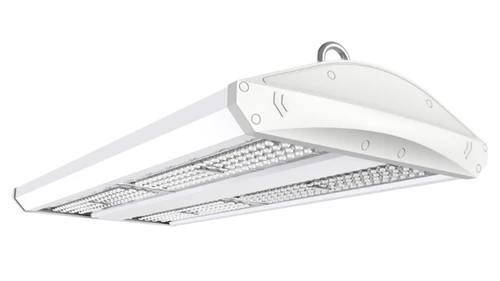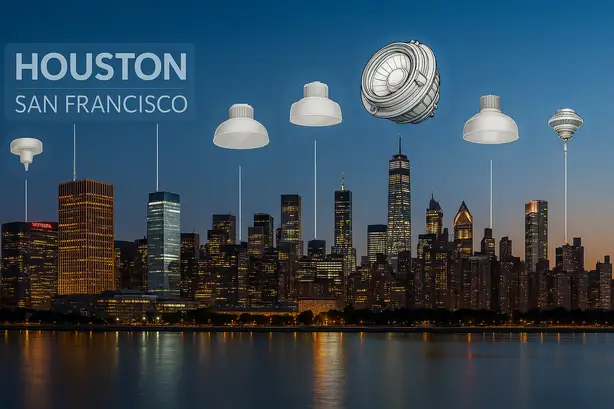Leading Nationwide Provider of Industrial & Explosion Proof LED Lighting
Maes Lighting provides certified, reliable explosion proof, high bay, marine, and commercial LED lighting solutions tailored to meet the demanding requirements of industries across the United States.
Trusted By Leading Businesses Across the USA
From Fortune 500 enterprises to innovative manufacturers, Maes Lighting has delivered certified LED lighting solutions for companies like Graybar, Sherwin-Williams, Conoco-Phillips, Blue Origin, and more. Our clients trust us for reliability, industry expertise, and nationwide service.
























Our Premium Lighting Solutions

Explosion Proof Lighting
Class 1 & 2 certified LED fixtures for hazardous or high-heat locations such as refineries, chemical plants, and gas facilities.

High Temperature Lighting
Extreme-heat LED flood and high bay fixtures for steel mills, foundries, glass plants, and harsh industrial spaces.

High Bay LED Lighting
High-efficiency LED high bays for warehouses, manufacturing plants, distribution centers, and gyms.

Flood & Area Lighting
Powerful area, flood, and parking lot LED lights for outdoor security, facility lots, and perimeter lighting.

Vapor Tight LED Lighting
Moisture-proof, dust-resistant LED vapor tight fixtures for food processing, car washes, and wet industrial environments.

Food Processing Lighting
NSF-approved, IP69K-rated food-grade LED high bays and vapor tight lights for cold storage, meat, and beverage plants.

Emergency & Exit Lighting
Reliable emergency, exit, and backup LED lighting for safety compliance in hazardous and industrial settings.

Marine & Boat Lighting
IP66/IP68 marine-rated LED flood and linear lights designed for boats, docks, ports, and harsh ocean environments.
Most Popular LED Lighting Products
Discover our top-selling LED lights trusted for hazardous locations, industrial plants, parking lots, food processing, marine environments, and more.
-

Explosion Proof Linear LED Light
EXI Series—Class 1 Div 2 certified, top choice for hazardous industrial applications.
-

UFO High Bay LED Light
LS-5EHB Model—energy‑efficient, high‑output UFO LED for warehouses and factories.
-

Vapor Tight LED Fixture
SL Series—IP69K, NSF‑listed, ideal for wet locations and food processing.
-

Parking Lot/Shoebox LED Area Light
LS‑ESBV Series—outdoor LED lighting for parking lots and commercial exteriors.
-

Food Grade High Bay LED
FY‑HB Series—NSF‑certified high bay LED for food processing and clean environments.
-

LED Flood Light (Outdoor/Area)
AST‑FL‑13 Series—large area flood lighting for industrial exteriors and yards.
-

Emergency & Exit LED Light
EX-ES03 Class 1 Div 1 Explosion Proof LED Exit & Emergency Light Combo—UL844 certified for reliable safety in hazardous locations.
-

Marine & Boat LED Flood Light
RT Series—IP66 rated, proven in harsh marine environments, operational in extreme cold.
-

High Temp LED High Bay
EDGE Series—engineered for extreme heat in steel mills and high‑temperature plants.
Why Partner with Maes Lighting?

Certified & Compliant
We deliver UL844, OSHA, NSF, and ETL-listed LED fixtures that meet all industrial and hazardous-location standards.

Nationwide Fast Shipping
New York to Seattle, get same-day quotes and rapid shipping to all 50 states.

Energy-Saving Performance
Our high-efficacy LEDs (up to 180 lm/W) cut energy costs by up to 75% vs. legacy lighting.

Custom Engineering Support
In-house design team tailors lighting layouts, photometric plans, and turnkey installation services.

Our Lighting is Certified & Trusted

TESTIMONIALS
Trusted by Industry Leaders

Juan Montealvo
I highly recommend Maes Lighting, they have high quality lights. Their cost is very competitive, and have always helped making my deliveries. Tommy Jacobs is always going above and beyond, when I'm in bind. He finds a way to get it done. Give them a shot on your lighting needs.


Walter Bumgarner
Having been in the electrical business for over 45 years we have ordered and installed explosion proof lights on many projects. We were very pleased with the quality and ease of installation of your product. We would highly recommend your product to others.


Trey Lewis
MAES was a great resource for our warehouse lighting retro-fit proijects. They presented options, and provided answers to all our questions. I've worked with Tommy on 2 location retro-fit projects, and would certainly recommend MAES.


R. Simpson
Working with Maes Lighting is a pleasure. He is key in our supply chain. He is always available, reliable and willing to offer feedback and solution ideas. Pricing and Delivery are top notch!

See Our Lighting Solutions in Action
Oil Rig with IR3 LED Class 1 Div 2 Lights
A major offshore oil rig required robust, explosion proof lighting to ensure safety and operational efficiency in hazardous locations. Maes Lighting supplied IR3 Series Class 1 Div 2 LED fixtures—delivering certified illumination designed to withstand the harshest environments and meet all UL and OSHA standards.
Natural Gas Pump Station with IR3 LED Class 1 Div 2 Lights
A natural gas pump station needed explosion proof, maintenance-free lighting for critical hazardous areas. Maes Lighting delivered IR3 Series Class 1 Div 2 LEDs for complete compliance and optimized safety—reducing downtime and ensuring 24/7 operational visibility.
Parking Lot Project with L Series Area Light
A large refinery’s parking lot was upgraded with energy-efficient L Series Area LED lights. The new lighting system improved security, safety, and visibility while cutting energy costs. Durable, high-output fixtures from Maes Lighting provide reliable performance in outdoor, high-traffic industrial environments.
Scrubber Area Project with EPLO3 LED Lighting
A large industrial facility needed reliable, high-output LED lighting for its scrubber area, where harsh chemicals and moisture were a concern. Maes Lighting supplied EPLO3 LED fixtures—engineered for superior chemical resistance and wet locations. The upgrade improved visibility, enhanced worker safety, and reduced maintenance downtime in this demanding environment.
Oil-Gas Facility with IR3 LED
An oil and gas facility required explosion proof LED lighting to ensure safe operations in hazardous Class 1 Div 2 areas. Maes Lighting delivered IR3 Series LED fixtures—providing bright, certified illumination that meets UL and OSHA standards. The new system enhanced operational safety and reliability across the site’s critical infrastructure.
Proudly Serving Major Markets Across America
Houston, TX – Explosion Proof & Industrial LED Lighting
Get Class 1 & 2 certified explosion proof LED fixtures, high bay lighting, and emergency lights for refineries, plants, and Houston’s industrial sector. Local inventory and fast nationwide shipping. See more →
Seattle, WA – Marine & Port Facility LED Lighting
Top-tier marine and boat LED flood lights, area lighting, and vapor tight fixtures for Seattle ports, shipyards, and marine service businesses. Saltwater and weather resistant. See more →
San Francisco, CA – Flood, Marine & Area Lighting
Marine-rated LED flood lights, outdoor parking lot fixtures, and commercial lighting for Bay Area ports, facilities, and city projects. Designed for harsh environments and energy savings. See more →
Chicago, IL – Industrial & Food Processing Lighting
Comprehensive LED solutions for Chicago’s manufacturing, food processing, and logistics industries. Explosion proof, vapor tight, and high bay lights available for all applications. See more →
New York, NY – Commercial & Property LED Lighting
Premium LED lighting for New York’s high-rises, property managers, and retail locations. Reliable, energy-efficient high bay, area, and emergency lights for urban projects. See more →

Expert Insights & Industry Resources
Class 1 Div 1 Explosion-Proof Lighting Guide | Maes Lighting
Discover the essentials of Class 1 Division 1 explosion proof LED lighting. Learn how to achieve compliance and protect hazardous locations with certified industrial lighting solutions.
April 21, 2025 • 4 min read
Top Paint Booth Lights and Wet Area LED Solutions for Safety and Quality | Maes Lighting
Explore top-rated LED lights for paint booths and wet areas. Find the best waterproof, high-CRI lighting solutions for safe, efficient finishing and industrial applications.
April 12, 2025 • 4 min read
EX-MV01: The Ultimate Portable Explosion-Proof LED Work Light | Maes Lighting
Learn how the EX-MV01 portable LED safety light delivers powerful, reliable illumination for hazardous locations. Ideal for on-site maintenance, inspections, and emergency lighting needs.
April 13, 2025 • 3 min read
Frequently Asked Questions
What types of industrial and commercial lighting solutions does Maes Lighting offer?
We offer explosion proof lighting, high bay LED lighting, marine and boat lighting, food processing lighting, vapor tight LED lighting, flood and area lighting, and emergency lighting, all available for fast delivery and expert support anywhere in the U.S.
Are your explosion proof LED lights certified for hazardous locations?
Yes, our explosion proof LED fixtures are certified for hazardous locations including Class 1 Division 1, Class 1 Division 2, Class 2 Division 1, and Class 2 Division 2. Our products meet stringent UL844 standards and OSHA requirements for use in industrial environments where safety and compliance are critical.
Can I request a custom lighting quote for my facility?
Absolutely! Our lighting experts can recommend, engineer, and quote a custom lighting solution for any industrial, marine, or commercial project—nationwide.
Talk to a Lighting Expert Today
Ready to improve your facility’s lighting efficiency and compliance? Get in touch with our experts for personalized recommendations and fast quotes.

Contact
Headquarters, Remote Operations
Maes Lighting
Broken Arrow, OK 74014
Mailing address available on request
Nationwide shipping and support,
Mon to Fri, 8 am to 6 pm CT





